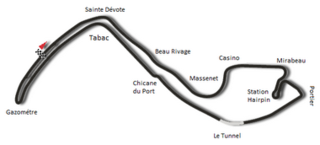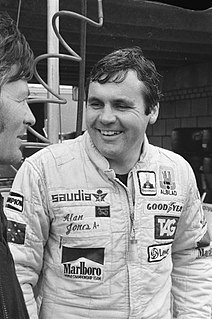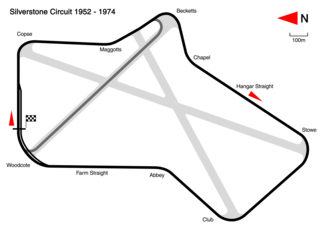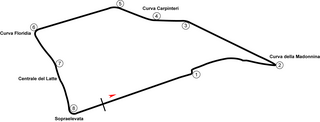
John Michael Hawthorn was a British racing driver. He became the United Kingdom's first Formula One World Champion driver in 1958, whereupon he announced his retirement, having been profoundly affected by the death of his teammate and friend Peter Collins two months earlier in the 1958 German Grand Prix. Hawthorn also won the 1955 24 Hours of Le Mans, but was haunted by his involvement in the disastrous crash that marred the race. Hawthorn died in a road accident three months after retiring.

Olivier Jean Marie Fernand Gendebien was a Belgian racing driver who was called "one of the greatest sportscar racers of all time".

The German Grand Prix was a motor race that was held most years since 1926, with 75 races having been held. The race has been held at only three venues throughout its history; the Nürburgring in Rhineland-Palatinate, Hockenheimring in Baden-Württemberg and occasionally AVUS in Berlin. The race continued to be known as the German Grand Prix, even through the era when the race was held in West Germany.

The Portuguese Grand Prix is a motorsports event that was first held in 1951 as a sportscar event, and then intermittently disappearing for many years before being revived again. In 1964 event was held as a sportscar race, and the 1965 and 1966 editions being held for Formula Three entrants. The event was part of the Formula One World Championship in 1958–1960, then again between 1984 and 1996, and after a long hiatus, it was revived from 2020 onwards. The event has been held at several circuits throughout its history.

The Italian Grand Prix is the fifth oldest national Grand Prix, having been held since 1921. In 2013 it became the most held Grand Prix. It is one of the two Grands Prix which has run as an event of the Formula One World Championship Grands Prix every season, continuously since the championship was introduced in 1950. Every Formula One Italian Grand Prix in the World Championship era has been held at Monza except in 1980, when it was held at Imola.

The 1958 Argentine Grand Prix was a Formula One motor race held on 19 January 1958 at Autodromo Municipal Ciudad de Buenos Aires Circuit. It was race 1 of 11 in the 1958 World Championship of Drivers and race 1 of 10 in the 1958 International Cup for Formula One Manufacturers. The race was the sixth Argentine Grand Prix. It was held on the #2 variation of the circuit. The race was held over 80 laps of the four kilometre circuit for a total race distance of 313 kilometres.

The 1958 Monaco Grand Prix was a Formula One motor race held on 18 May 1958 at Monaco. It was race 2 of 11 in the 1958 World Championship of Drivers and race 2 of 10 in the 1958 International Cup for Formula One Manufacturers. The race was the 16th Monaco Grand Prix and was held over 100 laps of the three kilometre circuit for a total race distance of 314 kilometres.

The 1983 FIA Formula One World Championship was the 37th season of FIA Formula One motor racing. It featured the 1983 Formula One World Championship for Drivers and the 1983 Formula One World Championship for Constructors, which were contested concurrently over a fifteen-race series that commenced on 13 March and ended on 15 October. Nelson Piquet won the Drivers' Championship, his second Formula One title and the first to be won by a driver using a turbocharged engine, while Ferrari won the Constructors' Championship. It was also the last Drivers' Championship won by a Brabham driver.

The 1980 Formula One season was the 34th season of FIA Formula One motor racing. It featured the 1980 World Championship of Drivers and the 1980 International Cup for F1 Constructors, which were contested concurrently from 13 January to 5 October over a fourteen-race series. The season also included one non-championship race, the Spanish Grand Prix.

The 1971 Formula One season was the 25th season of the Fédération Internationale de l'Automobile's Formula One motor racing. It featured the 22nd World Championship of Drivers and the 14th International Cup for F1 Manufacturers which were contested concurrently over eleven races between 6 March and 3 October. The season also included a number of non-championship races open to Formula One cars.
The 1961 Formula One season was the 15th season of Formula One motor racing. It featured the 1961 World Championship of Drivers and the 1961 International Cup for F1 Manufacturers, which were contested concurrently from 14 May to 8 October over an eight race series. The season also included numerous non-championship races for Formula One cars.
The 1959 Formula One season was the 13th season of FIA Formula One motor racing. It featured the 1959 World Championship of Drivers and the 1959 International Cup for F1 Manufacturers, contested concurrently over a nine-race series which commenced on 10 May and ended on 12 December. The season also included a number of non-championship Formula One races.
The 1957 Formula One season was the 11th season of FIA Formula One motor racing. It featured the 1957 World Championship of Drivers which commenced on 13 January 1957 and ended on 8 September after eight races. Juan Manuel Fangio won his fourth consecutive title, his fifth in total, in his final championship. A feat that would not be beaten until Michael Schumacher in 2003. The season also included numerous non-championship races for Formula One cars.

The 1951 Formula One season was the fifth season of FIA Formula One motor racing. It featured the 1951 World Championship of Drivers, which commenced on 27 May 1951 and ended on 28 October after eight races. The season also included 14 races that were open to Formula One cars but did not count towards the championship standings.

The 1950 Formula One season was the fourth season of the FIA's Formula One motor racing. It featured the inaugural FIA World Championship of Drivers which commenced on 13 May and ended on 3 September, as well as a number of non-championship races. The championship consisted of six Grand Prix races, each held in Europe and open to Formula One cars, plus the Indianapolis 500, which was run to AAA National Championship regulations. Giuseppe Farina won the championship from Juan Manuel Fangio and Luigi Fagioli.

The Coppa Acerbo was an automobile race held in Italy, named after Tito Acerbo, the brother of Giacomo Acerbo, a prominent fascist politician. Following Italy's defeat in World War II, and the consequent demise of fascism, the race was renamed the Circuito di Pescara, and in some years was also referred to as the Pescara Grand Prix and 12 Hours of Pescara. The race was run between 1924 and 1961 and over the years was held to a variety of vehicle class regulations and durations. In 1957 the Pescara Grand Prix formed a round of the Formula One World Championship, a race which still holds the record as having the longest circuit length ever used for a Championship event.

Luigi Musso was an Italian racing driver. In 1955 he joined the Ferrari team, entering into a fierce rivalry with Mike Hawthorn and Peter Collins, which boosted the performance of the team, but also encouraged greater risk-taking. According to Musso's fiancée, he was deep in debt by the time of the lucrative 1958 French Grand Prix, where he was fatally injured, somersaulting into a ditch while chasing Hawthorn.

The Race of Two Worlds, also known as the 500 Miglia di Monza, was an automobile race held at the Autodromo Nazionale Monza, Italy in 1957 and again in 1958. It was intended as an exhibition event, allowing American teams from the United States Auto Club (USAC) National Championship to compete directly against teams from the Formula One World Championship based in Europe. The two types of cars competed on the banked oval at Monza which had been completed in 1955. Due to the similarity to the Indianapolis Motor Speedway, where the USAC teams ran the Indianapolis 500, the event earned the nickname Monzanapolis.

The 10th BRDC International Trophy was a motor race, run to Formula One rules, held on 3 May 1958 at the Silverstone Circuit, England. The race was run over 50 laps of the Grand Prix circuit, and was won by British driver Peter Collins in a Ferrari Dino 246.

The 8th Syracuse Grand Prix was a motor race, run to Formula One rules, held on 13 April 1958 at Syracuse Circuit, Sicily. The race was run over 60 laps of the circuit, and was won by Italian driver Luigi Musso in a Ferrari Dino 246, who also took pole position and fastest lap.

















